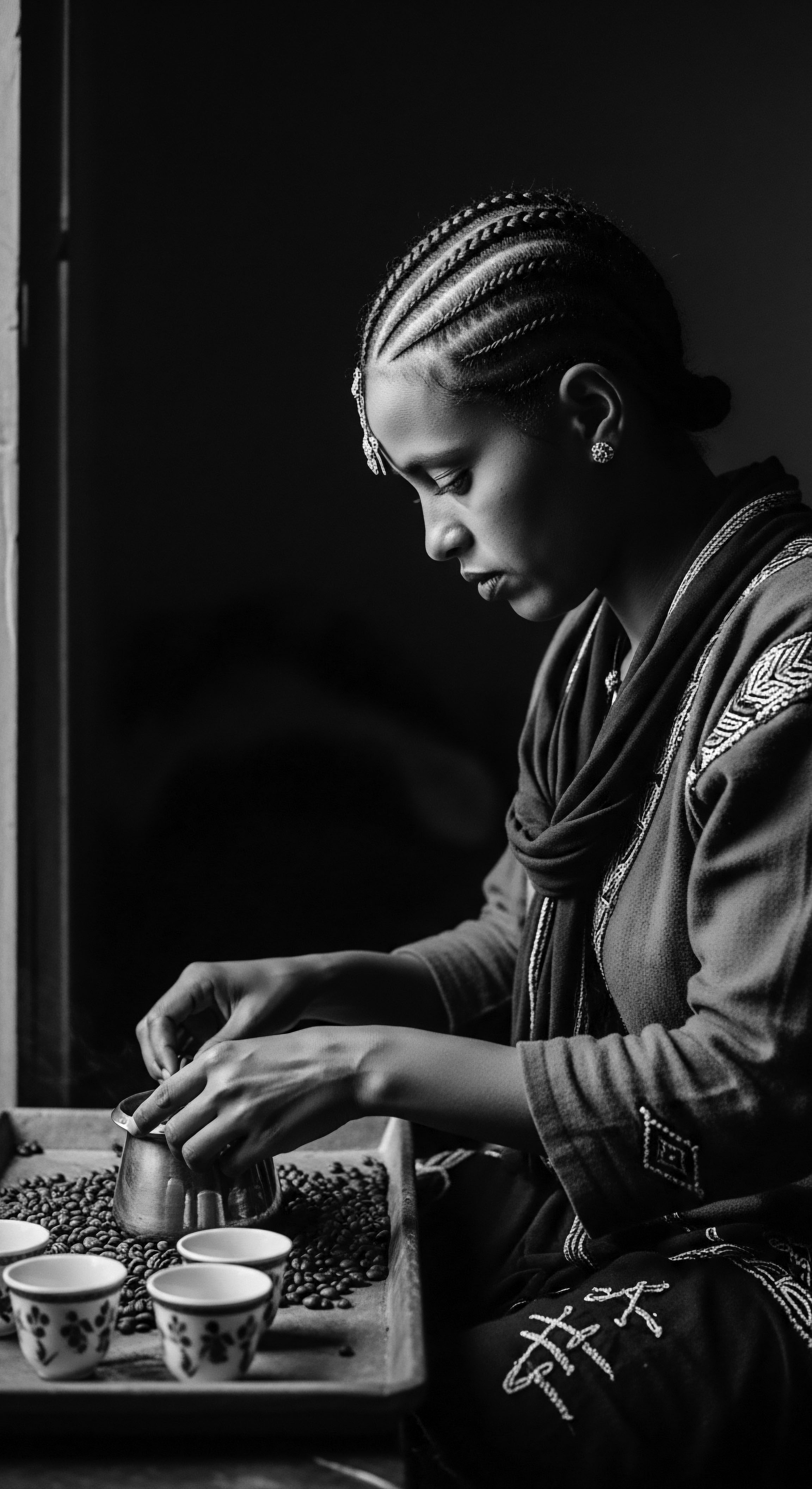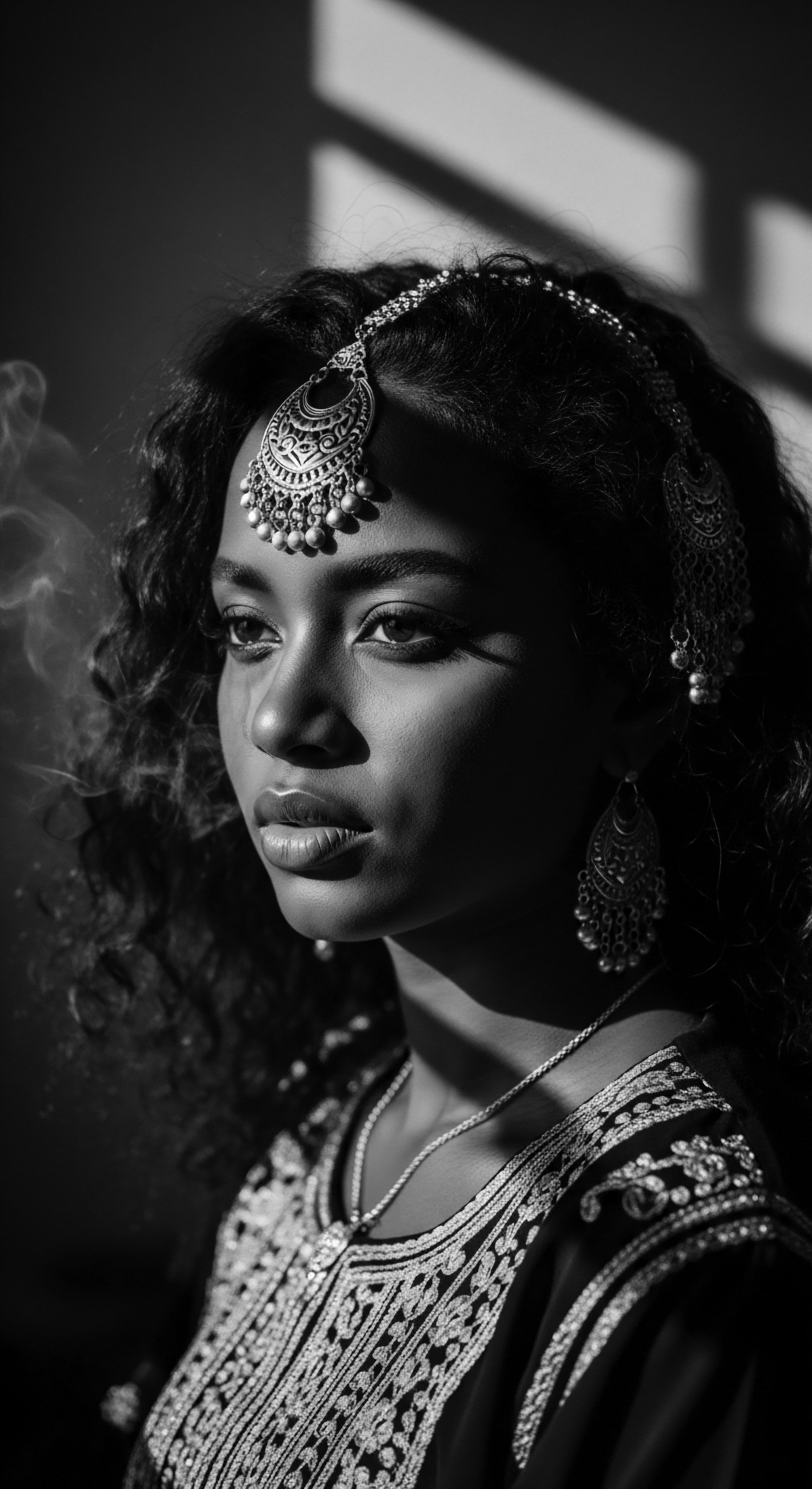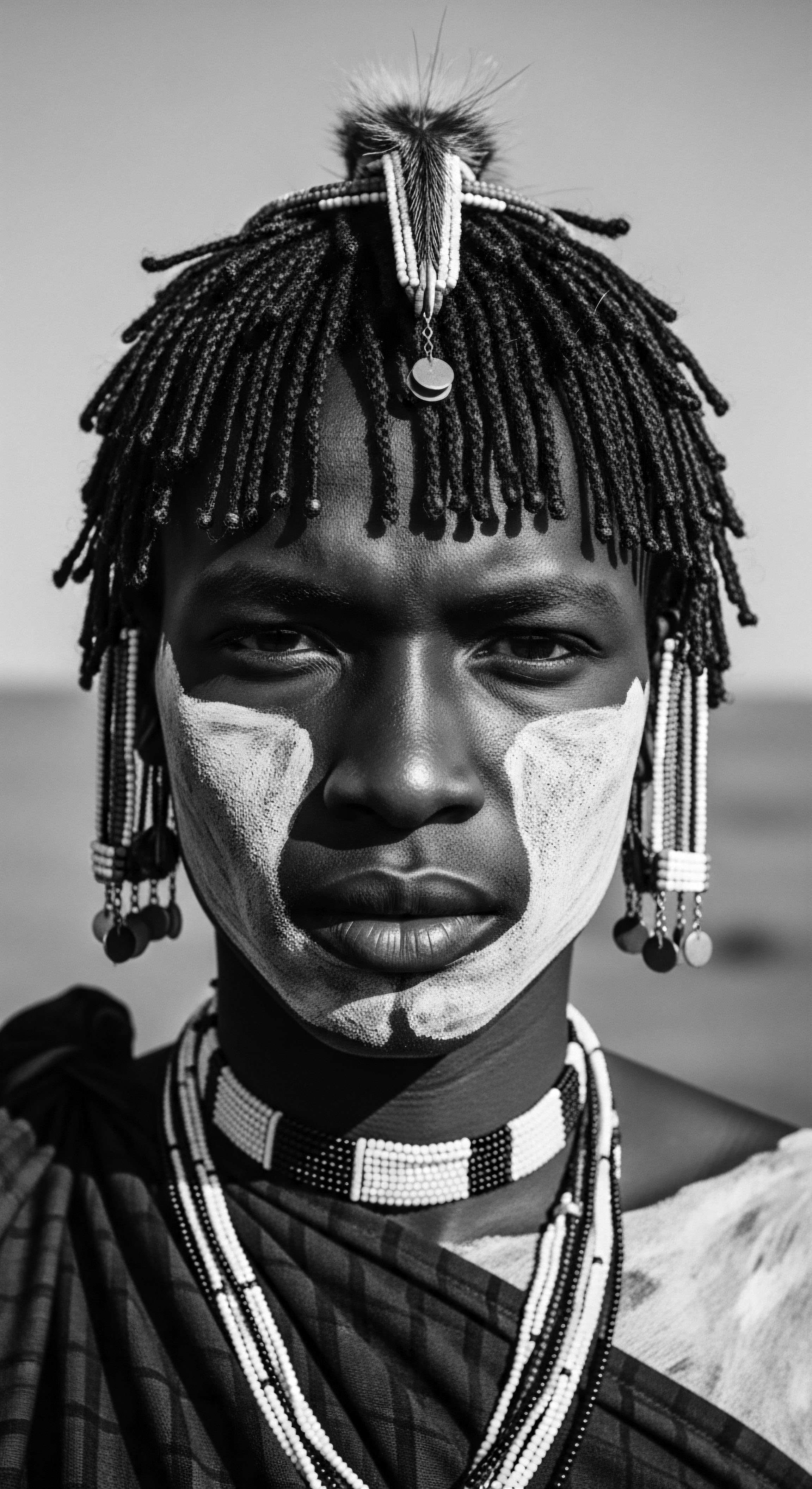
Roots
Consider, for a moment, the very ground beneath our feet—the earth, ancient and wise, holding stories etched into its strata. Within those layers reside mineral-rich clays, born from volcanic ash and geological shifts, a tangible link to the planet’s deep history. From these earthen gifts, a practice emerged across diverse cultures, particularly within African societies and their diasporic relatives, that transcended mere physical care. Clay application on textured hair became a profound expression of communal bonds and inherited wisdom, a silent language spoken through touch and shared ritual.
It connected individuals to their lineage, to the very essence of their land, and to the collective spirit of their people. This connection goes beyond the superficial; it speaks to the soul of a strand, tracing its journey from elemental biology to a powerful marker of identity and resilience.

The Earth’s Giving Nature and Hair’s Anatomy
Textured hair, with its unique helical structure, its varying degrees of curl, coil, and zig-zag patterns, possesses a distinct ancestral blueprint. These strands, often more susceptible to dryness due to the winding path of natural oils, and prone to tangling, presented specific care challenges and opportunities for ingenuity across generations. Ancient communities, long before the advent of modern microscopy, understood these characteristics through keen observation and iterative practice. They turned to the earth, recognizing in certain clays a remarkable kinship with their hair.
Clays, such as Bentonite and Kaolin, common in many parts of Africa and the Middle East, possess particular mineral compositions. Bentonite, an absorbent aluminum phyllosilicate clay formed from volcanic ash, holds high cation exchange capacity and absorptive properties (Williams & Haydel, 2010; Sarruf et al. 2023). This quality meant it could draw out impurities, excess oils, and accumulated substances from the scalp and hair fiber.
Kaolin, a gentler white clay, offers cleansing without stripping, acting as a mild purifier (Matike, Ekosse & Ngole, 2010; Sarruf et al. 2023). These clays, when moistened, form a soft, malleable paste, an ideal medium for ancestral hair care.
Clay application on textured hair was not simply a cosmetic act; it was a living dialogue between the earth’s ancient wisdom and the unique needs of a deeply rooted heritage.
The genius of ancestral hair practices lay in this intuitive understanding of earth’s chemistry. For example, the Ghassoul Clay, sourced from the Atlas Mountains in Morocco, has been used for centuries for its cleansing and healing attributes. Its name itself, derived from the Arabic word “ghasala,” means “to wash,” underscoring its primary role (Argiletz, 2024; Ecosystem Laboratoire, 2024). This historical usage, passed down from generation to generation, stands as a testament to the empirical knowledge developed over millennia, where the properties of the earth’s gifts were discovered and applied for tangible benefits to the hair and scalp.

Ancient Lexicons of Care
The language surrounding these practices was as rich and layered as the soil itself. Traditional terms, specific to particular ethnic groups, would denote not only the clay itself but also the method of its preparation, the precise application technique, and the occasion for its use. While precise terms for “clay application” on hair are localized and vary widely, the concept was embedded within broader descriptions of hair dressing, adornment, and ritual cleansing.
For instance, in some Igbo communities of Nigeria, various clays were applied to the body, including the hair, for beautification, with specific names for different shades and uses (Matike, Ekosse & Ngole, 2010). This naming convention reinforces the depth of understanding and intentionality behind each step of these ancient care routines.
The application of clay was often part of a wider, meticulous regimen, an ancestral understanding of hair health that acknowledged environmental factors, nutritional influences, and the inherent properties of textured strands. It speaks to a profound respect for the body and its natural expressions, seeing hair not as something to be tamed or altered to fit an external standard, but as an integral part of one’s being, to be nurtured and honored.

Ritual
The application of clay to textured hair, beyond its elemental composition, truly flourished within the context of communal ritual. These were not solitary acts performed in isolation; they were often collective experiences, woven into the very fabric of daily life, rites of passage, and celebrations. Such moments offered more than just physical grooming; they created powerful opportunities for social bonding, the transmission of cultural knowledge, and the reaffirmation of shared identity across generations. The hands that prepared the clay and applied it to a loved one’s hair were not just performing a task; they were carrying forward a legacy, imbuing each stroke with history and shared affection.

Communal Touch and Shared Wisdom
Across diverse African societies, hair grooming was, and remains, a profoundly social activity. It involved mothers, daughters, sisters, and friends gathering, often under the shade of a tree or within the confines of a home, sharing stories, laughter, and wisdom while meticulously tending to one another’s crowns (Fernandez Knight & Long, 2019; Akanmori, 2015). The process of applying clay would fit seamlessly into these communal sessions. The preparation of the clay itself—mixing it with water, perhaps infused with herbs or oils—could be a collaborative effort, each person contributing to the collective well-being.
This shared experience of hair care, punctuated by the rhythmic motions of detangling, cleansing, and styling, served as an informal classroom. Younger generations absorbed traditional techniques, learned about suitable ingredients, and understood the cultural significance of various hairstyles. Clay, with its tactile qualities, would become part of this sensory learning. The feeling of the cool, smooth paste on the scalp, the way it lifted impurities, the softness it imparted to the coils upon rinsing—these were lessons learned through direct experience, deepened by the presence and guidance of elders.
Hair grooming with clay transformed mundane care into meaningful moments of collective remembrance and continuity.

Adornment, Cleansing, and Cultural Markers
Clay served multiple purposes within these rituals.
- Cleansing Agent ❉ Certain clays, like bentonite, functioned as natural shampoos, drawing out dirt and excess oils without stripping the hair’s natural moisture, a vital property for textured hair prone to dryness (Regirl, 2021; HeyCurls, 2021). The clay’s negative charge attracts positively charged impurities, making it an effective clarifying agent (This is Not a Blog, 2018).
- Conditioning Treatment ❉ After cleansing, clays could also serve as conditioning treatments, helping to soften strands, reduce tangles, and enhance natural curl definition (Regirl, 2021; Clinikally, 2025). This was especially valuable for coils and curls, making them more manageable for subsequent styling.
- Adornment and Protection ❉ Beyond basic care, clay was used as a medium for adornment and protection. In certain cultures, colored clays—like red ochre or white clays—were applied to hair, not only for aesthetic appeal but also to signify social status, marital standing, or to prepare for specific ceremonies (Matike, Ekosse & Ngole, 2010; Bebrų Kosmetika, 2024). The Himba tribe of Namibia, for instance, are renowned for their use of red ochre mixed with butter fat on their hair, symbolizing life and earth, and acting as a protective layer against the sun (Bebrų Kosmetika, 2024; Mbilishaka, 2018a). This practice is a potent example of how utilitarian application intertwines with deep cultural meaning and identity.
The application of clay often preceded the intricate styling techniques that defined many African hairstyles, such as braids, twists, and locs (Patton, 2006). These styles, which could take hours or even days to complete, further cemented social bonds as individuals spent extended periods in close proximity, working together. The shared effort and time invested in hair care reinforced community ties, creating spaces of intimacy and mutual reliance. The tangible result was beautiful, well-tended hair, but the intangible benefit was a strengthened sense of belonging, a visible expression of collective heritage.
| Traditional Application Purpose Cleansing |
| Ancestral Practice (Clay Type/Method) Rhassoul clay mixed with water, applied to scalp and hair (Morocco) |
| Modern Scientific Understanding/Benefit Clay's negative charge attracts positively charged impurities, removing buildup and oils without harsh stripping. High absorption capacity. |
| Traditional Application Purpose Conditioning & Detangling |
| Ancestral Practice (Clay Type/Method) Bentonite clay paste worked through coils before styling (Various African communities) |
| Modern Scientific Understanding/Benefit Minerals in clay soften the hair cuticle, reducing knots and frizz, enhancing curl definition. |
| Traditional Application Purpose Scalp Health & Protection |
| Ancestral Practice (Clay Type/Method) Clay mixed with botanicals applied to scalp (West Africa) |
| Modern Scientific Understanding/Benefit Clays absorb toxins, regulate sebum, and can provide a physical barrier against environmental stressors like UV radiation. |
| Traditional Application Purpose Adornment & Identity Marker |
| Ancestral Practice (Clay Type/Method) Red ochre clay on Himba hair for social status and life stages (Namibia) |
| Modern Scientific Understanding/Benefit Pigmented clays offer natural color and visual impact, reinforcing cultural identity. |
| Traditional Application Purpose These traditional uses of clay for hair care demonstrate an intuitive ancestral understanding of mineral properties, which modern science continues to validate, underscoring a continuous heritage. |

Relay
The legacy of clay application on textured hair extends far beyond simple grooming; it constitutes a profound relay of ancestral wisdom, shaping not only individual identity but also the collective memory and resilience of Black and mixed-race communities. This deep understanding, passed through countless hands and whispered conversations, validates a holistic approach to care that transcends superficial beauty standards. It speaks to a living heritage, one that continues to inform and inspire our current grasp of textured hair health and cultural expression.

How Does Ancestral Clay Application Inform Holistic Wellness Today?
The wisdom embedded in traditional clay rituals offers a robust framework for contemporary holistic wellness, particularly for textured hair. Ancestral practitioners understood the interconnectedness of scalp health, hair vitality, and overall well-being. They recognized that a healthy scalp provides the foundation for thriving strands. Clay, with its purifying and mineral-rich properties, served as a cornerstone of this holistic approach.
It was applied not merely to cleanse the hair but to revitalize the scalp, drawing out impurities, balancing oil production, and providing essential minerals like calcium, magnesium, and potassium that contribute to hair strength (Clinikally, 2025; Regirl, 2021). This preventive and restorative care, practiced communally, reinforced shared values of health and mutual support.
Consider the Yoruba people of Nigeria, where certain hair rituals carry spiritual significance. While not exclusively clay-based, the general philosophy surrounding hair as a channel for spiritual connection (Akanmori, 2015; Langat, 2022) informs how any natural application, including clay, would be treated with reverence. An intriguing historical example comes from a study discussing the Agwuele (2019) research on certain communities where shaving rituals for children were held by the river. In these instances, the shaven hair was not discarded but kept as a mixture with medicinal ingredients in a clay pot containing river water.
This concoction, believed to possess healing properties, was consumed when a person fell ill (Agwuele, 2019, as cited in Matjila, 2020). While this example pertains to ingestion rather than direct hair application, it powerfully illustrates how clay, the vessel for medicinal brew, was seen as a potent element within community healing practices and spiritual continuity, directly linked to hair as a sacred part of the body and its connection to ancestral realms. This specific communal act, with hair and clay as central components, underscores the depth of belief in nature’s remedies and the collective responsibility for well-being.

Communal Identity and Problem-Solving Through Shared Practices
The communal application of clay provided a practical forum for collective problem-solving related to textured hair. Issues such as excessive dryness, tangling, or scalp irritation were addressed through shared knowledge and hands-on application. Elders would guide younger members in selecting the right clay, blending it with local botanicals such as herbs, plant extracts, or natural oils (Matike, Ekosse & Ngole, 2010; Bebrų Kosmetika, 2024) to enhance its efficacy.
This iterative process of observation, experimentation, and shared feedback refined techniques over generations. The collective wisdom ensured that the best practices for maintaining hair vitality were preserved and passed along, creating a collective repository of care.
The Hammam Ritual in North Africa, deeply tied to the use of Ghassoul clay, exemplifies this communal aspect of care. It’s a space where individuals gather, cleanse, and prepare their bodies, including their hair, in a shared environment. This shared experience fosters a sense of unity and cultural pride (Argiletz, 2024).
The very act of preparing the Ghassoul clay was a secretive, traditionally preserved ritual, passed from mother to daughter, often involving maceration of clay stones with herbs like orange blossom, chamomile, and lavender (Ghassoul Clay ❉ Origin & History Of This Amazing Wonder!, 2022). This highlights the intimate transmission of knowledge within family and community units.
The profound sociological impact of these grooming sessions extended beyond mere hygiene or aesthetics. They were vital for transmitting cultural values, strengthening family ties, and reinforcing collective identity markers (Johnson & Bankhead, 2014; Akanmori, 2015). For Black women, hair became, and remains, a potent symbol of racial identity, self-expression, and resistance against Eurocentric beauty norms (Jacobs-Huey, 2006; Lashley, 2018; Matjila, 2020). The communal acts of caring for textured hair with earth’s offerings thus became acts of communal affirmation, a quiet but powerful statement of self and belonging.
- Bentonite Clay ❉ Sourced from volcanic ash, it acts as a purifier for scalp and hair.
- Kaolin Clay ❉ A gentle white clay, known for its mild cleansing and soothing properties, suitable for sensitive scalps.
- Rhassoul/Ghassoul Clay ❉ Originating from the Atlas Mountains, prized for its cleansing, detangling, and mineralizing qualities, and its traditional use in hammam rituals.
In essence, the relay of knowledge concerning clay application is a continuous stream of ancestral genius, flowing through time to nourish and strengthen textured hair heritage. It is a story of intuition validated by science, of individual care nurtured by community, and of identity proclaimed through the very ground from which we arise.

Reflection
As we trace the path of clay, from the silent depths of the earth to its sacred place within textured hair heritage, a clear truth emerges ❉ this humble mineral holds stories far beyond its physical properties. It speaks of ingenuity, connection, and an enduring respect for the land that sustains us. The ‘Soul of a Strand’ ethos, for which Roothea stands, is beautifully embodied in this ancestral practice. Each coil and curl, nurtured by clay, carries the echoes of countless hands that came before, hands that mixed, applied, and shared in the intimate ritual of care.
This journey through clay’s historical and cultural uses is not an exploration of forgotten lore; it is a testament to living heritage. It reminds us that wellness is not simply a personal pursuit but a communal inheritance, a wisdom passed through the tender thread of shared experiences. In a world that often seeks to dissect and commodify, the practice of clay application, particularly for textured hair, stands as a quiet yet powerful act of reclamation and affirmation.
It grounds us in the profound knowledge that authentic beauty springs from a deep appreciation of our origins, a connection to the earth, and an honor for the ways our ancestors navigated their world. The wisdom of clay, therefore, invites us to look beyond immediate remedies, seeing instead a holistic tapestry where personal identity, communal strength, and ancestral legacy intertwine within every strand.

References
- Akanmori, H. (2015). Hairstyles, Traditional African. In The SAGE Encyclopedia of African Cultural Heritage in North America. SAGE Publications.
- Agwuele, A. (2019). The African Cultural System. In Matjila, C. R. (2020). The meaning of hair for Southern African Black women. University of the Free State.
- Argiletz. (2024). Ghassoul clay ❉ benefits and uses in beauty care.
- Bebrų Kosmetika. (2024). The Power of Hair in African Folklore ❉ Rituals and Traditions.
- Byrd, A. D. & Tharps, L. L. (2001). Hair Story ❉ Untangling the Roots of Black Hair in America. St. Martin’s Press.
- Clinikally. (2025). Bentonite Clay Hair Mask ❉ The Natural Way to Detox and Revive Your Hair.
- Ecosystem Laboratoire. (2024). Ghassoul ❉ history, benefits and uses.
- Fernandez Knight, S. M. & Long, W. (2019). Narratives of Black Women on Hair in the Workplace. PINS, 58, 27–49.
- Ghassoul Clay ❉ Origin & History Of This Amazing Wonder! (2022). Ghassoul Clay ❉ Origin & History Of This Amazing Wonder!.
- HeyCurls. (2021). 6 Amazing Bentonite Clay Hair Benefits & How To Use It.
- Jacobs-Huey, L. (2006). From the Kitchen to the Salon ❉ Black Women’s Hairdressing. Rutgers University Press.
- Johnson, D. B. & Bankhead, D. (2014). The Black hair experience ❉ A cultural, social, and psychological exploration. Peter Lang.
- Langat, M. (2022). Don’t Touch My Hair ❉ Examining the Natural Hair Movement Among Black Women. Asbury Theological Seminary.
- Matike, D. M. E. Ekosse, G. I. & Ngole, V. M. (2010). Indigenous knowledge applied to the use of clays for cosmetic purposes in Africa ❉ An overview. Indilinga ❉ African Journal of Indigenous Knowledge Systems, 9(2), 140-149.
- Matjila, C. R. (2020). The meaning of hair for Southern African Black women. University of the Free State.
- Mbilishaka, N. (2018a). PsychoHairapy ❉ Brushing Up on the History and Psychology of Black Hair. Psi Chi.
- Patton, M. T. (2006). Hair ❉ A Documentary. (Doctoral dissertation).
- Regirl. (2021). Bentonite Clay For Natural Hair ❉ Benefits, How to Use, and DIY Mask Recipe.
- Sarruf, F. D. Contreras, V. J. P. Martinez, R. M. Velasco, M. V. R. & Baby, A. R. (2023). The Scenario of Clays’ and Clay Minerals’ Use in Cosmetics/Dermocosmetics. Cosmetics, 10(6), 142.
- This is Not a Blog. (2018). Aztec Magic Healing Clay is, Well…Magical.
- Williams, L. B. & Haydel, S. E. (2010). Evaluation of the medicinal use of clay minerals as antibacterial agents. International Geology Review, 52(7-8), 745-770.
